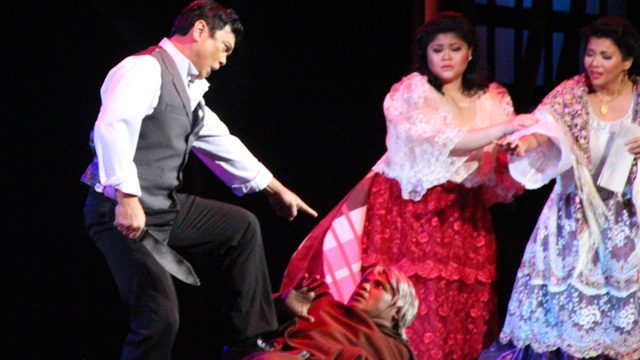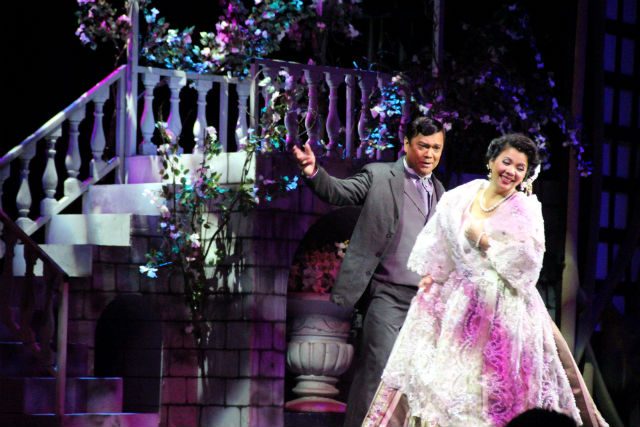SUMMARY
This is AI generated summarization, which may have errors. For context, always refer to the full article.

Opera has always been tough to love.
Like classical music and ballet, it was the product of a bygone age. Crafted for the eyes, ears, and tastes of a European aristocracy that has since been guillotined or dethroned, it wasn’t meant for today’s common man.
Often, it presumed knowledge of grecian, pagan, or gothic lore and mythology and its performance seemingly focused more on virtuosity than storytelling.
Unlike classical music and ballet that have both transcended language and that have both adapted to include contemporary developments, opera pieces are still very much tied to the language they were authored with and are still very much identified with their trademark vocal technique, bel canto.
Simply put, Giuseppe Verdi’s La Traviata and Robert Wagner’s Der Ring des Nibelungen would cease to be if they were translated from their original Italian and German. And while Giacomo Puccini’s 1896 opera La Boheme was successfully reinterpreted as a 1990s rock musical about AIDS-afflicted underground artists in New York, Jonathan Larson’s Rent simply isn’t opera anymore without the bel canto.
Seemingly highfalutin and foreign, opera can be a struggle for modern day Filipinos to enjoy.
Thankfully, all these are not a problem for Noli Me Tangere (Touch Me Not), an opera authored in 1953 by composer Felipe P. De Leon and librettist Guillermo Tolentino in pure Tagalog and based on the eponymous 1887 novel by national hero Jose Rizal. It’s a story that was required reading for most Filipinos growing up.
Besides familiarity both with this opera’s language and narrative, Rizal’s timeless tale of romance and revenge is still very much relevant to today’s generation as corruption, religious meddling in governance, colonial mentality, and class struggle are still issues of the day as they were in Rizal’s era. Noli Me Tangere is the one opera today’s Filipino can easily love.
Home coming
After sold-out performances at New York’s Hunter College last October and Washington’s Kennedy Center last August as well as a US premiere at Chicago’s Harris Theatre on May 2012, Noli Me Tangere: The Opera comes to Manila to run from September 11 to 28 at the Newport Performing Arts Theater, Resorts World Manila, Pasay City. (READ: ‘Noli Me Tangere’ opera coming to Manila)
The cast includes Sal Malaki and Ivan Niccolo C. Nery as Crisostomo Ibarra, Maria Rachelle R. Gerodias and Myramae T. Meneses as Maria Clara, Antoni Mendezona and Jean Judith Z. Javier as Sisa, Noel P. Azcona and Greg A. De Leon as Elias, Andrew Fernando and Jonathan Velasco as Padre Damaso, Maria Carmila L. Molina and Maria Carmila L. Molina as Tia Isabel, Roby Malubay as Pilosopo Tasio, Reginald Santiago B. Velasco and Joaquin Ignacio D. Samonte as Basilio, and Jose Luis Mari F. Yapjoco and Mark Cedrick Imperial as Crispin.
Behind the scenes are director Freddie Santos, stage and costume designer Jerry Sibal, and lighting designer Shax Siasoco. Providing live music is the Manila Philharmonic Orchestra led by Maestro Rodel Colmenar.
This show is made possible by Filipino-American philanthropist Loida Nicolas Lewis, executive producer Jerry Sibal, assistant executive producer Edwin Josue, and Mark and Christine Manalang of Ultimate Shows, Inc.
Beyond the glamour
At the premier on September 11, it was high society matrons and their spouses, not theater cognoscenti and art lovers, that comprised most of the audience. The event was more of an opportunity to see and be seen in haute couture ternos and barong tagalogs as well as various indigenous costumes.

The venue had admirably done its best to be inclusive and accommodating of all audiences. English subtitles ran on at the top of the proscenium arch as well as at the bottom of the two video screens that flanked the stage, both of which showed live closeups of the actors onstage for the benefit of audiences seated at extreme angles to the right and left of the stage.
Theater acoustics and sound system insured that both the singers and the orchestra were heard clearly without distortion. However, in stark contrast, sound effects seemed absolutely canned and artificial. There was also, quite strangely, some barely there but still audible radio music interfering and intruding into the sound system.
The set designs were brilliant, literally, with all the colors vibrant and vivid. Despite the almost fluorescent quality of some of the props and costumes, the stage and lighting design made it work.
The only discordant elements in costume design were the obvious artifice of Padre Damaso’s blond wig, the unflattering and unsightly cuts on Elias’ shirt, and the general lack of a realistic “worn-in” look on Sisa, Elias, Basilio, and the Guardia Civil’s clothes.
On the other hand, the immaculate intricacy of the ternos worn by Maria Clara and other characters from society’s elite were befitting of their characters.
Besides actual props, the backdrop was one huge video flatscreen screen that displayed various scenes rendered digitally, from forests and cemeteries to mansion interiors and moonlit al fresco revelries.
Though quite straightforward and unsurprising, this approach was nonetheless effective, except for a riverside scene where a computer animated crocodile seemed cartoonish both in its portrayal and movement.
Ultimately, an opera is judged by the singing and acting of its cast. The material authored by De Leon, reminiscent of Puccini, provided a great venue for these opera singers to shine. And the ensemble for the premier night in Manila acquitted themselves admirably.
Most memorable was Mendezona as Sisa, who, driven mad by the disappearance of her two sons, wanders the forest, beautifully echoing the trilling of birds, matching note for note the orchestra’s avian warbles and chirps.
Gerodias, as Maria Clara, commanded attention in every scene of hers. Her singing was charismatic and her presence magnetic.
Malaki, as Maria Clara’s beau Crisostomo Ibarra, possessed the onstage chemistry with Gerodias that was necessary for this romantic role as well as the gravitas to become this opera’s much-aggrieved protagonist.
The cast was as effective as storytellers and actors as they were singers. Simply put, without looking at the english subtitles, I understood what they sang in Tagalog. And I didn’t just hear what they sang; I felt it.
Noli Me Tangere: The Opera, with its current cast, crew and venue in Manila, is a worthy watch, not only for the merit of its virtuosity, but also for its entertainment value. Yes, I truly enjoyed this opera. So will you. – Rappler.com
For tickets, visit www.ticketworld.com.ph.
Writer, graphic designer, and business owner Rome Jorge is passionate about the arts. Formerly the Editor-in-Chief of asianTraveler Magazine, Lifestyle Editor of The Manila Times, and cover story writer for MEGA and Lifestyle Asia Magazines,Rome Jorge has also covered terror attacks, military mutinies, mass demonstrations as well as Reproductive Health, gender equality, climate change, HIV/AIDS and other important issues. He is also the proprietor of Strawberry Jams Music Studio.
Add a comment
How does this make you feel?
There are no comments yet. Add your comment to start the conversation.